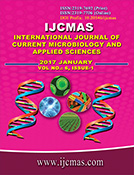


 National Academy of Agricultural Sciences (NAAS)
National Academy of Agricultural Sciences (NAAS)

|
PRINT ISSN : 2319-7692
Online ISSN : 2319-7706 Issues : 12 per year Publisher : Excellent Publishers Email : editorijcmas@gmail.com / submit@ijcmas.com Editor-in-chief: Dr.M.Prakash Index Copernicus ICV 2018: 95.39 NAAS RATING 2020: 5.38 |
Bacterial vaginosis is caused by an imbalance of the organisms that naturally exist in the vagina. The importance of bacterial vaginosis with respect to pregnant women’s health is emphasized by the association between bacterial vaginosis and adverse outcome of pregnancy. The aim of present study was to evaluate the direct smear microscopy and culture for determination of bacteria from vaginal discharge of pregnant women. Vaginal discharge in women is sometimes caused by candida and aerobic bacteria organisms like E.coli, staphylococcus aureus, and β- haemolytic streptococcus. Culture and sensitivity testing are done from high vaginal swab (HVS) specimen collected from women who come to the clinic complaining of vaginal discharge. Isolation and antibiotic sensitivity of these organisms are key to the successful treatment of the cause of vaginal discharge. This study tends to evaluate the microbial and antibiotic sensitivity and resistance pattern of high vaginal swab culture results in the Rajeev Gandhi government women and children hospital, Puducherry India. A total of 500 High Vaginal Swabs (HVS) were collected from pregnant women and were screened for bacterial population. For each patient one swab was used for smear preparation and Gram staining and the second swab was used for cultivation. HVS Samples culture and sensitivity results were reviewed. Out of which 252(50.4%) are the pathogenic organisms and 248(49.6%) yielded growth of non pathogenic organisms. Candida species were the predominant microbial organism, 27% (68/252). Bacterial Vaginosis causing bacteria identified were mostly the aerobic types (184); with Escherichia coli being predominant, 38.8% (98/184) followed by Klebsiella sps, and Staph. aureus. Pregnant women of age group 20-30 are showing more pathogenic isolates growth. Amikacin (89.6%), Norfloxacin (75.6%), Ciprofloxacin (66.2%) and Gentamycin (68.4%) revealed high levels of susceptibility. Whereas high resistance rates were observed for Amoxicillin (83.3%) Tetracyclin (65.4%) and Cotrimoxizole (62.7%). The cephalosporins showed the best antibiotic sensitivity. Candida spp. and aerobic bacteria were the predominant microbial organisms identified from HVS results in the Puducherry. Proper laboratory diagnosis to identify causative organisms is vital for optimal therapeutic outcome.
 |
 |
 |
 |
 |